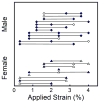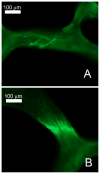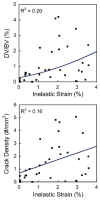Quantitative relationships between microdamage and cancellous bone strength and stiffness
- PMID: 24928495
- PMCID: PMC4125443
- DOI: 10.1016/j.bone.2014.05.023
Quantitative relationships between microdamage and cancellous bone strength and stiffness
Abstract
Microscopic tissue damage (microdamage) is an aspect of bone quality associated with impaired bone mechanical performance. While it is clear that bone tissue submitted to more severe loading has greater amounts of microdamage (as measured through staining), how microdamage influences future mechanical performance of the bone has not been well studied, yet is necessary for understanding the mechanical consequences of the presence of microdamage. Here we determine how stained microdamage generated by a single compressive overload affects subsequent biomechanical performance of cancellous bone. Human vertebral cancellous bone specimens (n=47) from 23 donors (14 males, 9 females, 64-92years of age) were submitted to a compressive overload, stained for microdamage, then reloaded in compression to determine the relationship between the amount of microdamage caused by the initial load and reductions in mechanical performance during the reload. Damage volume fraction (DV/BV) caused by the initial overload was related to reductions in Young's modulus, yield strength, ultimate strength, and yield strain upon reloading (p<0.05, R(2)=0.18-0.34). The regression models suggest that, on average, relatively small amounts of microdamage are associated with large reductions in reload mechanical properties: a 1.50% DV/BV caused by a compressive overload was associated with an average reduction in Young's modulus of 41.0±3.2% (mean±SE), an average reduction in yield strength of 63.1±4.5% and an average reduction in ultimate strength of 52.7±4.0%. Specimens loaded beyond 1.2% (1.2-4.0% apparent strain) demonstrated a single relationship between reload mechanical properties (Young's modulus, yield strength, and ultimate strength) and bone volume fraction despite a large range in amounts of microdamage. Hence, estimates of future mechanical performance of cancellous bone can be achieved using the bone volume fraction and whether or not a specimen was previously loaded beyond ultimate strain. The empirical relationships provided in this study make it possible to estimate the degree of impaired mechanical performance resulting from an observed amount of stained microdamage.
Keywords: Biomechanics; Bone quality; Cancellous bone; Mechanical testing; Microdamage.
Copyright © 2014 Elsevier Inc. All rights reserved.
Figures






References
-
- Burr DB, Forwood MR, Fyhrie DP, Martin RB, Schaffler MB, Turner CH. Bone microdamage and skeletal fragility in osteoporotic and stress fractures. J Bone Miner Res. 1997;12:6–15. - PubMed
-
- Schaffler MB, Choi K, Milgrom C. Aging and matrix microdamage accumulation in human compact bone. Bone. 1995;17:521–525. - PubMed
-
- Mori S, Harruff R, Ambrosius W, Burr DB. Trabecular bone volume and microdamage accumulation in the femoral heads of women with and without femoral neck fractures. Bone. 1997;21:521–6. - PubMed
-
- Fazzalari NL, Forwood MR, Smith K, Manthey BA, Herreen P. Assessment of cancellous bone quality in severe osteoarthrosis: bone mineral density, mechanics, and microdamage. Bone. 1998;22:381–8. - PubMed
-
- Zioupos P. Ageing human bone: factors affecting its biomechanical properties and the role of collagen. J Biomater Appl. 2001;15:187–229. - PubMed
Publication types
MeSH terms
Grants and funding
LinkOut - more resources
Full Text Sources
Other Literature Sources

